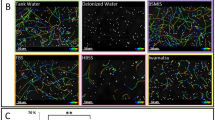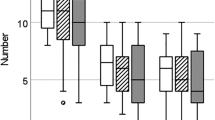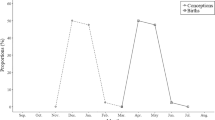Abstract
Monodelphis domestica, commonly called the laboratory opossum, is a useful laboratory animal for studying marsupial embryogenesis and mammalian development. Females breed year-round and the animals can be sustainably bred indoors. The authors draw on their own laboratory's experience to supplement previously published research on laboratory opossums. They describe a breeding protocol that reliably produces timed-pregnant M. domestica. Additionally, the authors discuss general laboratory opossum husbandry techniques and describe how to collect, handle and culture embryos.
This is a preview of subscription content, access via your institution
Access options
Subscribe to this journal
We are sorry, but there is no personal subscription option available for your country.
Buy this article
- Purchase on Springer Link
- Instant access to full article PDF
Prices may be subject to local taxes which are calculated during checkout









Similar content being viewed by others
References
Hedrich, H. ed. The Laboratory Mouse (Elsevier Academic, New York, 2004).
Mouse Genome Sequencing Consortium. Initial sequencing and comparative analysis of the mouse genome. Nature 420, 520–562 (2002).
Rossant, J. & Scherer, S.W. The mouse genome sequence - the end of the tail, or just the beginning? Genome Biol. 4, 109 (2003).
Prosser, H. & Rastan, S. Manipulation of the mouse genome: a multiple impact resource for drug discovery and development. Trends Biotechnol. 21, 224–232 (2003).
Buaas, F.W. Mouse genomics gets the royal treatment. Genome Biol. 5, 310 (2004).
Selwood, L. & Woolley, P.A. A timetable of embryonic development, and ovarian and uterine changes during pregnancy, in the stripe-faced dunnart, Sminthopsis macroura (Marsupialia: Dasyuridae). J. Reprod. Fertil. 91, 213–217 (1991).
Selwood, L. & Hickford, D. in Cell Lineage and Fate Determination (ed. Moody S.A.) 505–520 (Academic, San Diego, CA, 1998).
Selwood, L. Marsupial pre-implantation embryos in vivo and in vitro. Prog. Clin. Biol. Res. 294, 225–236 (1989).
Hickford, D.E., Merry, N.E., Johnson, M.H. & Selwood, L. Induced ovulation, mating success and embryonic development in the stripe-faced dunnart, Sminthopsis macroura. Reproduction 2, 777–783 (2001).
Fadem, B.H., Trupin, G.L., Maliniak, E., VandeBerg, J.L. & Hayssen, V. Care and breeding of the gray, short-tailed opossum (Monodelphis domestica). Lab. Anim. Sci. 32, 405–409 (1982).
VandeBerg, J.L. & Robinson, E.S. The laboratory opossum (Monodelphis domestica) in laboratory research. ILAR J. 38, 4–12 (1997).
Gouin, N. et al. Linkage mapping and physical localization of the major histocompatibility complex region of the marsupial Monodelphis domestica. Cytogenet. Genome Res. 112, 277–285 (2006).
Deakin, J.E., Parra, Z.E., Graves, J.A. & Miller, R.D. Physical mapping of T cell receptor loci (TRA@, TRB@, TRD@ and TRG@) in the opossum (Monodelphis domestica). Cytogenet. Genome Res. 112, 342K (2006).
Deakin, J.E., Olp, J.J., Graves, J.A. & Miller, R.D. Physical mapping of immunoglobulin loci IGH@, IGK@ and IGL@ in the opossum (Monodelphis domestica). Cytogenet. Genome Res. 114, 94H (2006).
Zimek, A. & Weber, K. The organization of the keratin I and II gene clusters in placental mammals and marsupials show a striking similarity. Eur. J. Cell Biol. 85, 83–89 (2006).
Go, Y. Lineage-specific expansions and contractions of the bitter taste receptor gene repertoire in vertebrates. Molec. Biol. Evol. 5, 964–972 (2006).
Zeller, U. & Freyer, C. Early ontogeny and placentation of the grey short-tailed opossum, Monodelphis domestica (Didelphidae: Marsupialia): contribution to the reconstruction of the marsupial morphotype. J. Zool. Syst. Evol. Res. 39, 137–158 (2001).
Vitazka, M.E. et al. Progesterone receptor in the forebrain of female gray short-tailed opossums: effects of exposure to male stimuli. Horm. Behav. 55, 190–196 (2009).
Harder, J.D., Jackson, L.M. & Koester, D.C. Behavioral and reproductive responses of female opossums to volatile and nonvolatile components of male suprasternal gland secretion. Horm. Behav. 54, 741–747 (2008).
Lammers, A.R. & Gauntner, T. Mechanics of torque generation during quadrupedal arboreal locomotion. J. Biomech. 7, 2388–2395 (2008).
Olkowicz, S., Turlejski, K., Bartkowska, K., Wielkopolska, E. & Djavidian, R.L. Thalamic nuclei in the opossum Monodelphis domestica. J. Chem. Neuroanat. 36, 85–97 (2008).
Riley, D.E. & Krieger, J.N. Embryonic nervous system genes predominate in searches for dinucleotide simple sequence repeats flanked by conserved sequences. Gene 15, 74–79 (2009).
Riley, D.E. & Krieger, J.N. UTR dinucleotide simple sequence repeat evolution exhibits recurring patterns including regulatory sequence motif replacements. Gene 15, 80–86 (2009).
Kushwaha, R.S., VandeBerg, J.F., Rodriguez, R., Chan, J. & VandeBerg, J.L. Low-density lipoprotein apolipoprotein B production differs between laboratory opossums exhibiting high and low lipemic responses to dietary cholesterol and fat. Metabolism 54, 1075–1081 (2005).
Mikkelsen, T.S. et al. Genome of the marsupial Monodelphis domestica reveals innovation in non-coding sequences. Nature 447, 167–178 (2007).
Samollow, P.B. The opossum genome: insights and opportunities from an alternative mammal. Genome Res. 18, 1199–1215 (2008).
Wang, Z., Hubbard, G.B., Clubb, F.J. & VandeBerg, J.L. The laboratory opossum (Monodelphis domestica) as a natural model for human cancer research. Int. J. Clin. Exp. Pathol. 2, 286–299 (2009).
Cothran, E.G., Aivaliotis, M.J. & VandeBerg, J.L. The effects of diet on growth and reproduction in gray short-tailed opossums (Monodelphis domestica). J. Exp. Zool. 236, 103–114 (1985).
Kraus, D.B. & Fadem, B.H. Reproduction, development and physiology of the gray short-tailed opossum (Monodelphis domestica). Lab. Anim. Sci. 37, 478–482 (1987).
Fadem, B.H., Taylor-Ali, L. & Erianne, D.C. The hormonal induction of mating behavior in female gray short-tailed opossums (Monodelphis domestica). Horm. Behav. 30, 44–49 (1996).
Fadem, B.H., Erianne, G.S. & Karen, L.M. The hormonal control of scent marking and precopulatory behavior in male gray short-tailed opossums (Monodelphis domestica). Horm. Behav. 23, 381–192 (1989).
Trupin, G.L. & Fadem, B.H. Sexual behavior of the gray short-tailed opossum (Monodelphis domestica). J. Mammal. 63, 409–414 (1982).
Mate, K.E., Robinson, E.S., VandeBerg, J.L. & Pedersen, R.A. Timetable of in vivo embryonic development in the grey short-tailed opossum (Monodelphis domestica). Mol. Reprod. Dev. 39, 365–374 (1994).
Selwood, L., Robinson, E.S., Pedersen, R.A. & VandeBerg, J.L. Development in vitro of Marsupials: a comparative review of species and timetable of cleavage and early blastocyst stages of development in Monodelphis domestica. Int. J. Dev. Biol. 41, 397–410 (1997).
Harder, J.D. & Jackson, L.M. Male pheromone stimulates ovarian follicular development and body growth in juvenile female opossums (Monodelphis domestica). Reprod. Biol. Endocrinol. 1, 21 (2003).
Keyte, A.L. & Smith, K.K. Opossum (Monodelphis domestica): A marsupial development model. Cold Spring Harb. Protoc. doi:10.1101/pdb.emo104 (2008).
Jackson, L.M. & Harder, J.D. Evidence for spontaneous postlactational estrus in gray short-tailed opossums (Monodelphis domestica). Biol. Reprod. 62, 1823–1827 (2000).
Cruz, Y.P., Hickford, D. & Selwood, L. A staging scheme for assessing development in vitro of organogenesis stage embryos of the stripe-faced dunnart, Sminthopsis macroura (Marsupialia: Dasyuridae). J. Reprod. Fertil. 120, 99–108 (2000).
Miller, R.D., Grabe, H. & Rosenberg, G.H. VH repertoire of a marsupial (Monodelphis domestica). J. Immunol. 294, 259–265 (1998).
Van Nievelt, A.F.H. & Smith, K.K. Tooth eruption in Monodelphis domestica and its significance for phylogeny and natural history. J. Mammal. 86, 333–341 (2005).
Dooley, T.P., Mattern, V.L., Moore, C.M. & Robinson, E.S. UV-induced melanoma. A karyotype with a single translocation is stable after allografting and metastasis. Cancer Genet. Cytogenet. 83, 155–159 (1995).
Dooley, T.P. et al. Cell lines derived from ultraviolet radiation-induced benign melanocytic nevi in Monodelphis domestica exhibit cytogenetic aneuploidy. Cancer Genet. Cytogenet. 71, 55–66 (1993).
Witton, C.J., Swann, K., Carroll, J. & Moore, H.D. Injection of a boar sperm factor causes calcium oscillations in oocytes of the marsupial opossum, Monodelphis domestica. Zygote 7, 271–277 (1999).
Moore, H.D. Gamete biology of the new world marsupial, the grey short-tailed opossum, Monodelphis domestica. Reprod. Fertil. Dev. 8, 605–615 (1996).
Taggart, D.A., O'Brien, H.P. & Moore, H.D. Ultrastructural characteristics of in vivo and in vitro fertilization in the grey, short-tailed opossum, Monodelphis domestica. Anat. Rec. 237, 21–37 (1993).
Taggart, D.A., Johnson, J.L., O'Brien, H.P. & Moore, H.D. Why do spermatozoa of American marsupials form pairs? A clue from the analysis of sperm-pairing in the epididymis of the grey short-tailed opossum, Monodelphis domestica. Anat. Rec. 236, 465–478 (1993).
Baker, P.J., Moore, H.D., Burgess, A.M. & Mittwoch, U. Gonadal sex differentiation in embryos and neonates of the marsupial, Monodelphis domestica: arrest of testis development in post-term embryos. J. Anat. 182, 267–273 (1993).
Baker, P.J., Moore, H.D., Penfold, L.M., Burgess, A.M. & Mittwoch, U. Gonadal sex differentiation in the neonatal marsupial, Monodelphis domestica. Development 109, 699–703 (1990).
Baggott, L.M., Davis-Butler, S. & Moore, H.D.M. Characterization of oestrus and timed collection of oocytes in the grey short-tailed opossum, Monodelphis domestica. J. Reprod. Fertil. 79, 105–114 (1987).
Knott, G.W., Dziegielewska, K.M., Habgood, M.D., Li, Z.S. & Saunders, N.L. Albumin transfer across the choroid plexus of South American opossum (Monodelphis domestica). J. Physiol. 499, 179–194 (1997).
Chuah, M.I., Tennet, R. & Teague, R. Developmental anatomy of the primary olfactory pathway in the opossum Monodelphis domestica. Histol. Histopathol. 12, 799–806 (1997).
Tennent, R. & Chuah, M.I. Ultrastructural study of ensheathing cells in early development of olfactory axons. Dev. Brain Res. 95, 135–139 (1996).
Balslev, Y., Saunders, N.R. & Møllgard, K. Onset of neocortical synaptogenesis in neonatal Monodelphis domestica (South American grey short-tailed opossum). Synapse 10, 267–270 (1992).
Mann, M.A., Kinsley, C., Broida, J. & Svare, B. Infanticide exhibited by female mice: genetic, developmental and hormonal influences. Physiol. Behav. 30, 697–702 (1983).
McCarthy, M.M. Oxytocin inhibits infanticide in female house mice (Mus domesticus). Horm. Behav. 24, 365–375 (1990).
Botten, J., Ricci, R. & Hjelle, B. Establishment of a deer mouse (Peromyscus maniculatus rufinus) breeding colony from wild-caught founders: comparison of reproductive performance of wild-caught and laboratory-reared pairs. Comp. Med. 51, 314–318 (2001).
Takahashi, L.K. & Lore, R.K. Intermale and maternal aggression in adult rats tested at different ages. Physiol. Behav. 29, 1013–1018 (1982).
Blanchard, R.J., Flannelly, K.J. & Blanchard, D.C. Life-span studies of dominance and aggression in established colonies of laboratory rats. Physiol. Behav. 43, 1–7 (1988).
Giordano, A.L., Siegel, H.I. & Rosenblatt, J.S. Effects of mother-litter separation and reunion on maternal aggression and pup mortality in lactating hamsters. Physiol. Behav. 33, 903–906 (1984).
Baggott, L.M. & Moore, H.D.M. Early embryonic development of the grey short-tailed opossum, Monodelphis domestica, in vivo and in vitro. J. Zool. 222, 623–639 (1990).
Moore, H.D.M. & Taggart, D.A. In vitro fertilization and embryo culture in the grey short-tailed opossum, Monodelphis domestica. J. Reprod. Fertil. 98, 267–264 (1993).
Tyndale-Biscoe, H. & Renfree, M.B. Reproductive Physiology of Marsupials (Cambridge University Press, Cambridge, UK, 1987).
Villarin, J.J., Schaeffer, P.J., Markle, R.A. & Lindstedt, S.L. Chronic cold exposure increases liver oxidative capacity in the marsupial Monodelphis domestica. Comp. Biochem. Physiol. A Mol. Integr. Physiol. 136, 621–630 (2003).
Thompson, E.N., Biknevicius, A.R. & German, R.Z. Ontogeny of feeding function in the gray short-tailed opossum Monodelphis domestica: empirical support for the constrained model of jaw biomechanics. J. Exp. Biol. 206, 923–932 (2003).
Schaeffer, P.J., Villarin, J.J. & Lindstedt, S.L. Chronic cold exposure increases muscle oxidative structure and function in Monodelphis domestica, a marsupial lacking brown adipose tissue. Physiol. Biochem. Zool. 76, 877–887 (2003).
Miles, K.G. et al. Ultrasonographic pregnancy detection and inhalation anesthesia in the gray short-tailed opossum (Monodelphis domestica). Lab. Anim. Sci. 47, 280–282 (1997).
Padykula, H.A. & Taylor, J.M. Ultrastructural evidence for loss of the trophoblastic layer in the chorioallantoic placenta of Australian bandicoots (Marsupialia: Peramelidae). Anat. Rec. 6, 357–385 (1976).
Padykula, H.A. & Taylor, J.M. Marsupial placentation and its evolutionary significance. J. Reprod. Fertil. Suppl. 31, 95–104 (1982).
Hall, J., Cruz, Y. & Harder, J. Behavioral responses of male laboratory opossums (Monodelphis domestica) to odors of estrous and anestrous females. Poster, 13th Annual Meeting of the Society for Behavioral Neuroendocrinology, Michigan State University, East Lansing, Michigan (2009).
Roberts, C.T. & Breed, W.G. Placentation in the dasyurid marsupial, Sminthopsis crassicaudata, the fat-tailed dunnart, and notes on placentation of the didelphid, Monodelphis domestica. J. Reprod. Fertil. 100, 105–113 (1994).
Harder, J.D., Stonerook, M.J. & Pondy, J. Gestation and placentation in two New World opossums: Didelphis virginiana and Monodelphis domestica. J. Exp. Zool. 266, 463–479 (1993).
Acknowledgements
We thank Lori Lindsey for technical assistance and an anonymous reviewer for helpful comments and suggestions. Research in Y.P.C.'s lab is supported by grants from the National Science Foundation (#0718404) and Grants-in-Aid from Oberlin College.
Author information
Authors and Affiliations
Corresponding author
Ethics declarations
Competing interests
The authors declare no competing financial interests.
Rights and permissions
About this article
Cite this article
Rousmaniere, H., Silverman, R., White, R. et al. Husbandry of Monodelphis domestica in the study of mammalian embryogenesis. Lab Anim 39, 219–226 (2010). https://doi.org/10.1038/laban0710-219
Received:
Accepted:
Issue Date:
DOI: https://doi.org/10.1038/laban0710-219
This article is cited by
-
Epigenetic clock and methylation studies in marsupials: opossums, Tasmanian devils, kangaroos, and wallabies
GeroScience (2022)
-
Marsupials that model melanoma
Lab Animal (2015)



